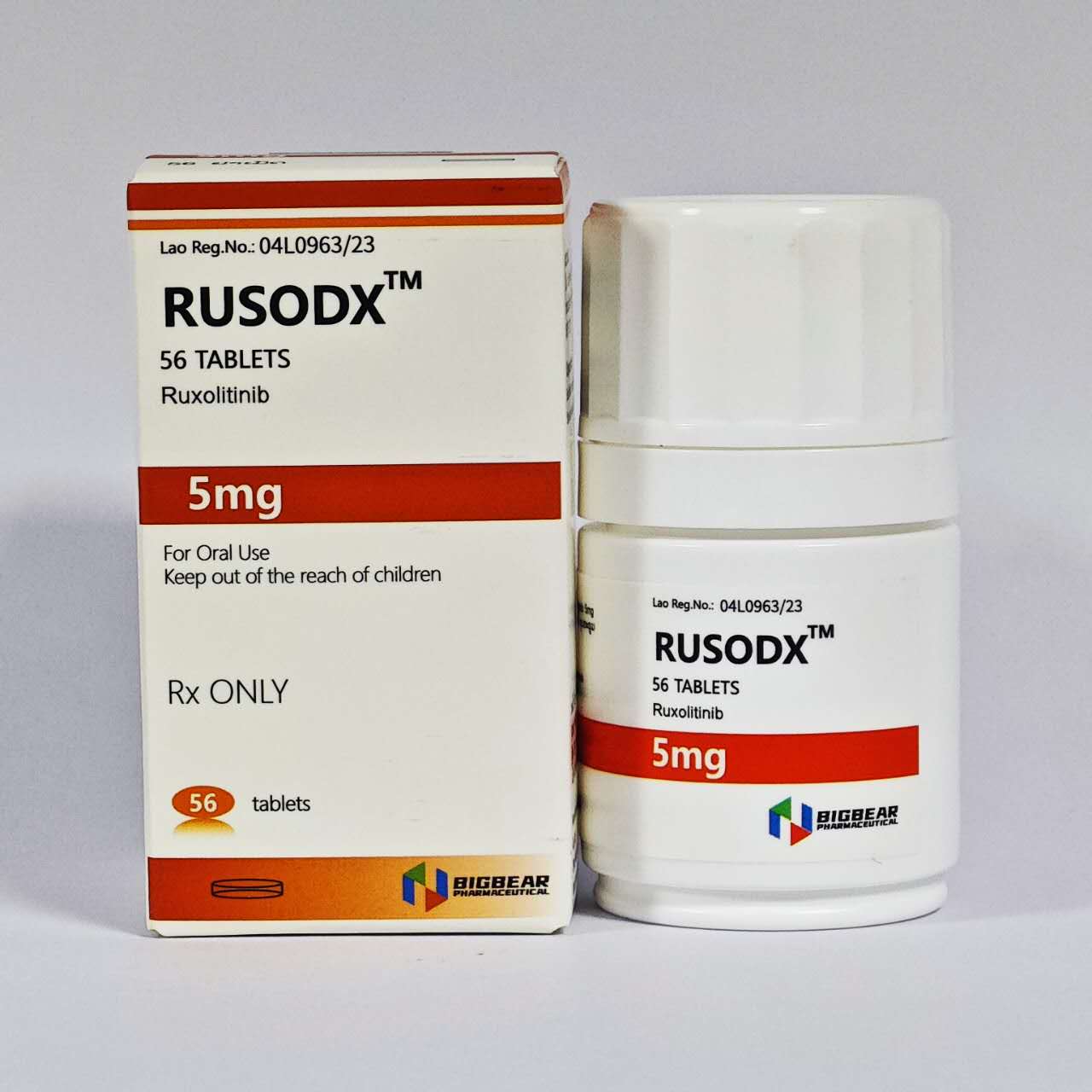RUSODX, Ruxolitinib 5mg
Manufactor:Bigbear Pharmaceutical Laos
Introduction:In November 2011, ruxolitinib tablets were first approved for marketing in the United States for the treatment of myelofibrosis. Subsequently, new indications were successively expanded, including plant-versus-host disease (GVHD) and polycythemia vera. In September 2021, ruxolitinib cream was launched in the United States for the short-term and discontinuous long-term treatment of non-immunocompromised patients with mild to moderate atopic dermatitis aged 12 and over.
chat onlinePhone: +8562052137046
Recommended
- details
【Drug Name】
Name: Ruxolitinib Tablets
Product Name: RUSODX
【Specification】
5mg
【Indications】
• adults with certain types of myelofibrosis (MF).
• adults with polycythemia vera (PV) who have already taken a medicine called hydroxyurea and it did not work well enough or they could not tolerate it.
• adults and children 12 years of age and older with acute graft-versus-host-disease (aGVHD) who have taken corticosteroids and they did not work well enough.
• adults and children 12 years of age and older with chronic graft-versus-host-disease (cGVHD) who have taken one or two types of treatments and they did not work well enough.
It is not known if RUSODX is safe or effective in children for treatment of myelofibrosis or polycythemia vera.
【Recommended Dosage】
• Take RUSODX exactly as your healthcare provider tells you.
• Do not change your dose or stop taking RUSODX without first talking to your healthcare provider.
• You can take RUSODX with or without food.
• RUSODX may also be given through certain nasogastric tubes.
o Tell your healthcare provider if you cannot take RUSODX by mouth. Your healthcare provider will decide if you can take RUSODX through a nasogastric tube.
o Ask your healthcare provider to give you specific instruction on how to properly take RUSODX through a nasogastric tube.
• If you miss a dose of RUSODX, take your next dose at your regular time. Do not take 2 doses at the same time.
• If you take too much RUSODX call your healthcare provider or go to the nearest hospital emergency room right away.
• You will have regular blood tests during your treatment with RUSODX. Your healthcare provider may change your dose of RUSODX or stop your treatment based on the results of your blood tests.
【Side Effects】
Low blood cell counts. RUSODX may cause low platelet counts (thrombocytopenia), low red blood cell counts (anemia), and low white blood cell counts (neutropenia). If you develop bleeding, stop RUSODX and call your healthcare provider. Your healthcare provider will do a blood test to check your blood cell counts before you start RUSODX and regularly during your treatment with RUSODX. Tell your healthcare provider right away if you develop or have worsening of any of these symptoms:
• unusual bleeding
• shortness of breath
• bruising
• fever
• tiredness
Infection. You may be at risk for developing a serious infection during treatment with RUSODX. Tell your healthcare provider if you develop any of the following symptoms of infection:
• chills
• vomiting
• aches
• weakness
• fever
• painful skin rash or blisters
• nausea
Cancer. Some people have had certain types of non-melanoma skin cancers during treatment with RUSODX. Your healthcare provider will regularly check your skin during your treatment with RUSODX. Tell your healthcare provider if you develop any new or changing skin lesions during treatment with RUSODX.
Cholesterol increases. You may have changes in your blood cholesterol levels during treatment with RUSODX. Your healthcare provider will do blood tests to check your cholesterol levels about every 8 to 12 weeks after you start taking RUSODX, and as needed.
Increased risk of major cardiovascular events such as heart attack, stroke or death in people who have
cardiovascular risk factors and who are current or past smokers while using another JAK inhibitor to treat rheumatoid arthritis.
Get emergency help right away if you have any symptoms of a heart attack or stroke while taking RUSODX, including:
• discomfort in the center of your chest that lasts for more than a few minutes, or that goes away and comes back
• severe tightness, pain, pressure, or heaviness in your chest, throat, neck, or jaw
• pain or discomfort in your arms, back, neck, jaw, or stomach
• shortness of breath with or without chest discomfort
• breaking out in a cold sweat
• nausea or vomiting
• feeling lightheaded
• weakness in one part or on one side of your body
• slurred speech
Increased risk of blood clots. Blood clots in the veins of your legs (deep vein thrombosis, DVT) or lungs (pulmonary embolism, PE) have happened in people taking another JAK inhibitor for rheumatoid arthritis and may be lifethreatening.
• Tell your healthcare provider right away if you have any signs and symptoms of blood clots during treatment with RUSODX, including:
o swelling, pain or tenderness in one or both legs
o sudden, unexplained chest or upper back pain
o shortness of breath or difficulty breathing
Possible increased risk of new (secondary) cancers. People who take another JAK inhibitor for rheumatoid arthritis have an increased risk of new (secondary) cancers, including lymphoma and other cancers. People who smoke or who smoked in the past have an added risk of new cancers.
The most common side effects of RUSODX in adults with certain types of MF and PV include:
• low platelet counts
• dizziness
• low red blood cell counts
• headache
• bruising
• diarrhea
The most common side effects of RUSODX in people with aGVHD include:
• low red blood cell counts
• infections
• low platelet counts
• swelling
• low white blood cell counts
The most common side effects of RUSODX in people with cGVHD include:
• low red blood cell counts
• low platelet counts
• infections, including viral infections
These are not all of the possible side effects of RUSODX.
Call your doctor for medical advice about side effects.
【Storage】
• Store RUSODX at room temperature 68°F to 77°F (20°C to 25°C).
Keep RUSODX and all medicines out of the reach of children.

 中文
中文
